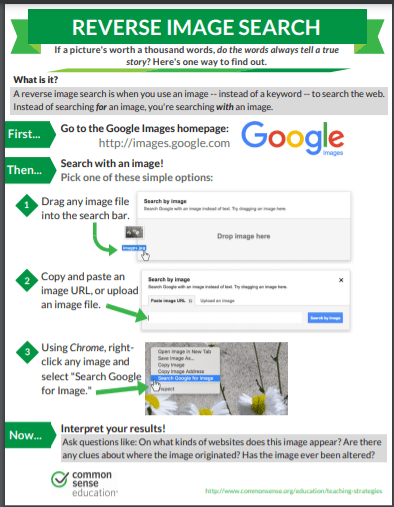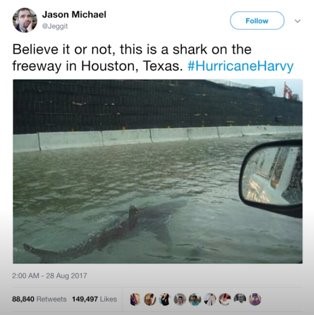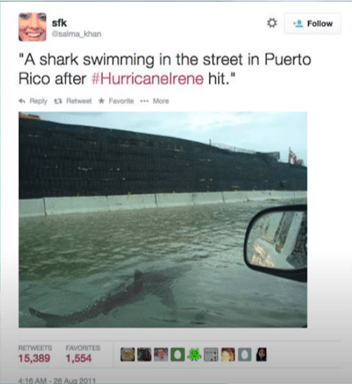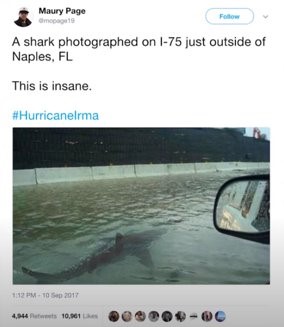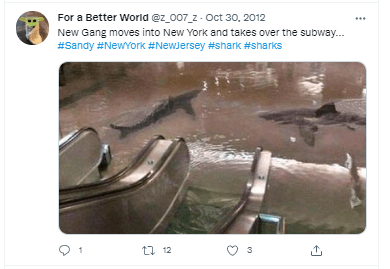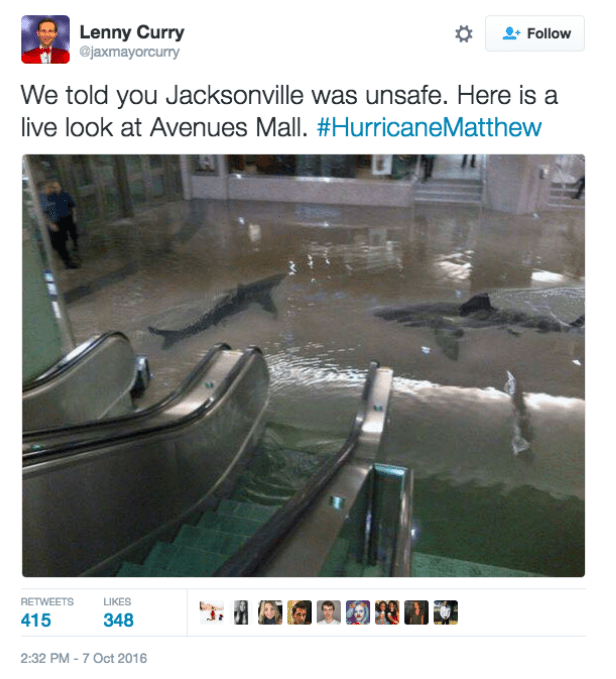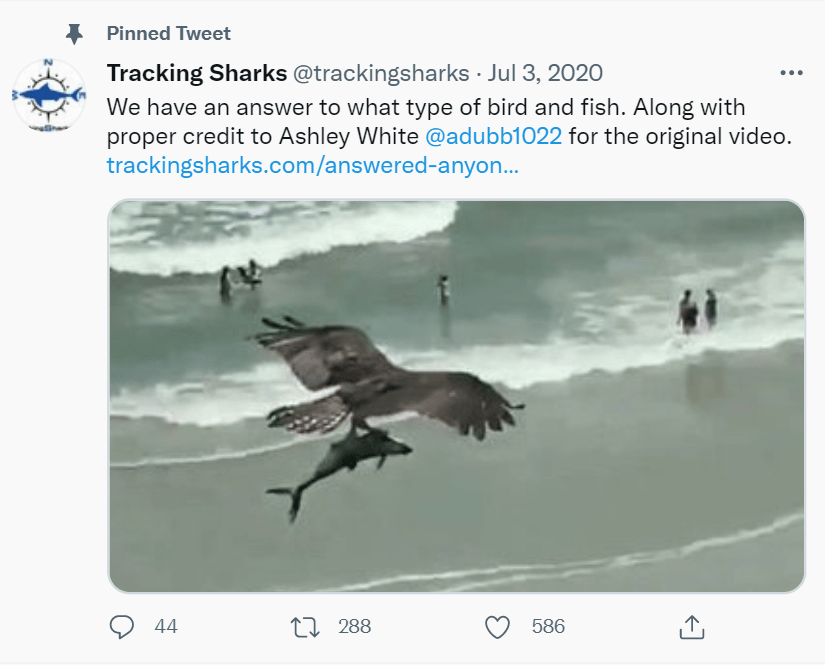Lesson Plan 2
Believe It—Or Not! When Photos Lie – part of a series on the lateral reading strategy
The photos and instructions for this lesson are mounted in their OneNote notebook and on Schoology as Instagram and Twitter are blocked for students.
Standards: RI 6.3 Analyze in detail how a key individual, event, or idea is introduced, illustrated, and elaborated in a text (e.g., through examples or anecdotes)., ISTE 3(b): Students evaluate the accuracy, perspective, credibility and relevance of information, media, data or other resources.
Learning Target: Students can use Google reverse image search to fact check internet photos for manipulation
Vocabulary: “photoshopped,” digitally alter, manipulate
ENTRY TASK/HOOK: Display the picture of the tweet below and ask students:
What’s going on in this picture? Do you believe it? Why or why not?
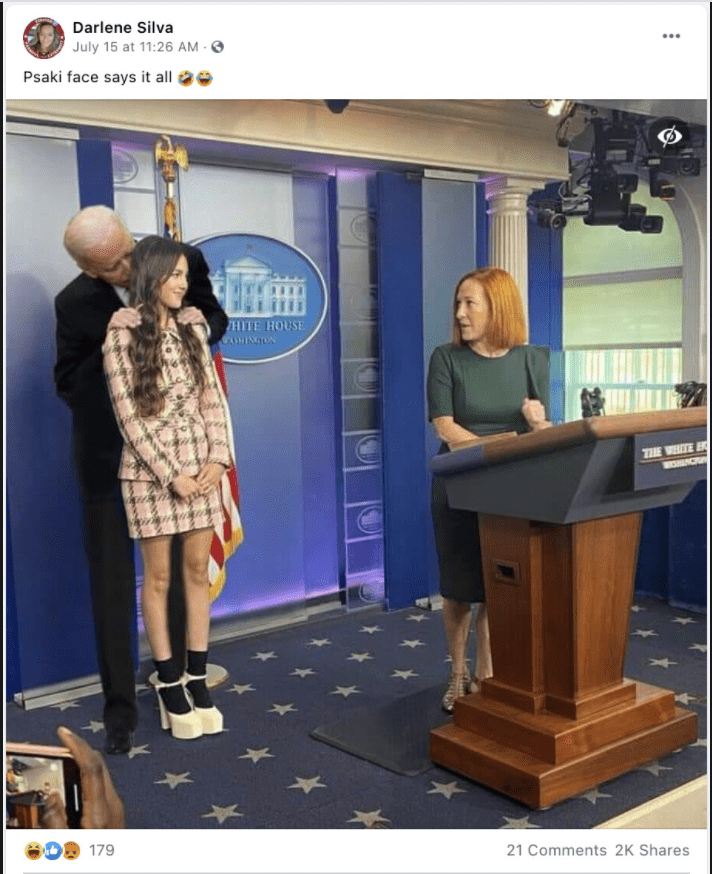
Share out student answers. Discuss vocabulary: “photoshop”(brand name), digitally alter, manipulate
Ask: What questions do you have about this photo? Is any of this information provided?
Who took it? Where was it taken? When was it taken? Why was it taken? Was it altered? If so, why? Who benefits from this?
Ask: What can you do to check whether it’s real or not?
DIRECT INSTRUCTION: How can we determine whether a photo is real or whether it has been altered? Demonstrate the steps to a Google Reverse Image Search using the photo above (and make a flipped video of this).
Read results – for this photo, it takes some sifting through results. Demo this.
Show students the resources for remembering how to do the search:
- Watch video on using Google image search (PBS Common Sense Education)
- Post instructions (anchor chart) for doing a Google reverse image search.
PRACTICE:
In pairs, students use the process on this photo:
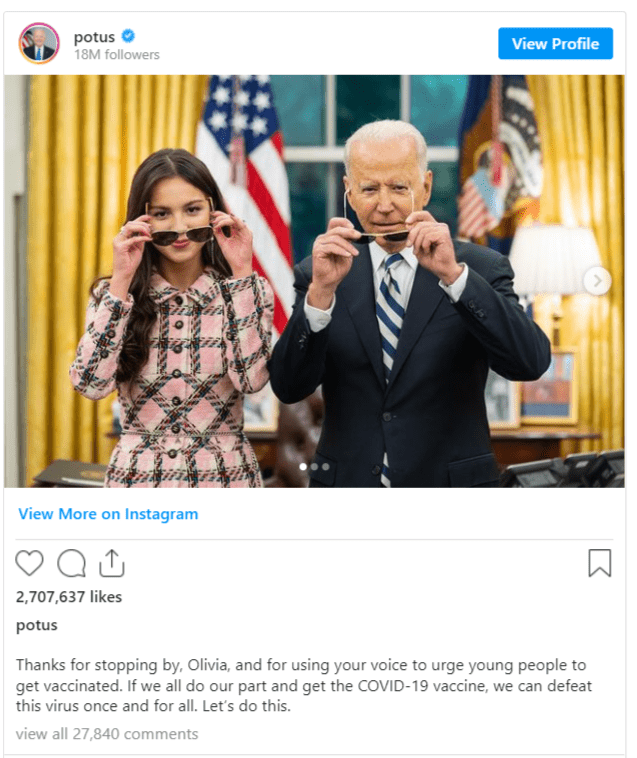
Then do a jigsaw practice with other photos (on Schoology). In pairs, students will be assigned a photo and will:
- predict whether it is fake or real and support their answer with reasons,
- do a Google reverse image search and read the results,
- give a final answer of whether it is altered or real and give justification for their answers.
Because Instagram and Twitter are blocked, paste these pictures into Schoology page instead of providing links.
The reveal on the above: https://www.youtube.com/watch?v=I_hRd_R1oP8
Have students ALSO do THIS ONE (which is real—but taken from 17th floor balcony so perspective makes people look small)
WRAP-UP:
Have students present their group’s findings or do a gallery walk of findings (post-its on posters) and complete an exit ticket with their findings.
Extension:
Watch the Jr. Scholastic video on fake news (password protected)
Read the Jr. Scholastic article (available in PDF – unformatted text attached below) and answer the questions:
- According to the article, why do people believe that altered photos are real? Cite evidence from the text in your answer.
- According to the article, what are some effects of the spread of fake photos? Cite evidence from the text in your answer.
Other Lesson resources:
https://junior.scholastic.com/pages/content-hubs/digital-literacy/lesson-plan-when-photos-lie.html (password protected)
1080L
When Photos Lie
Fake images are tricking countless people on social media. Here’s why that matters—and how you can avoid getting fooled.
By Laura Anastasia and Mary Kate Frank
The incredible image appeared on Twitter just hours after Hurricane Harvey struck Texas in August 2017. In the photo (see below), a great white shark swims alongside drivers on a flooded Houston highway. It’s no surprise that hundreds of thousands of people clicked on the post, and many shared it. The pic was even broadcast on national news.
The problem? The image was fake. A hoaxster had used photo-editing software to insert the fearsome predator into a picture of a flooded road.

Thomas P. Peschak/National Geographic Creative (real shark image)
The shark shot is one example of a fast-growing problem in the digital age: phony photos. As tech tools once available only to pros become more accessible and sophisticated, just about anyone can alter photographs.
Some doctored images are meant to be a joke (think: a pic of your birthday party with Beyoncé added in). But others are created to spread lies and stir up controversy. Russian operatives, for instance, filled social media networks with phony images as part of an effort to influence the 2016 U.S. presidential election.
Like other forms of fake news, manipulated photos can make people believe things that aren’t true. They can be even more powerful than fake articles, experts say, because people are more likely to trust a photograph. Plus, images arouse strong feelings in people instantly, says John Silva of the nonprofit News Literacy Project.
“With the right image and the right headline,” he says, “you can manipulate people’s emotions and make them believe all sorts of things.”Remaining Time -2
The Power of Images
It’s not always easy to spot a fake. In a study by Warwick University in England, people could identify manipulated images only about 60 percent of the time. Even when people did detect a phony pic, most couldn’t pinpoint what had been altered.
Many sham photos seem authentic because they were created from real images that have been changed only slightly. For example, this past March, a fake picture surfaced on Twitter of teen gun-control activist Emma González appearing to tear up a copy of the U.S. Constitution (see photo, below). The real photo shows González, a survivor of the Parkland, Florida, school shooting, ripping a gun-range target.
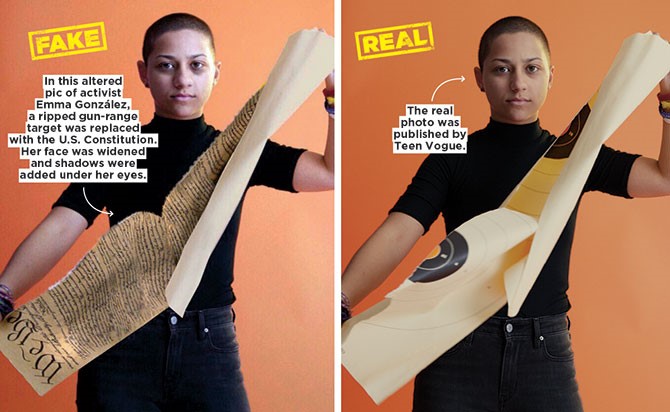
Tyler Mitchell (real Emma image)
The fake was posted by a bot (or robot) account on Twitter. It prompted outrage, especially among gun- rights activists. That’s the goal of many fake photos: to stir up strong feelings around hot-button issues. In this case, the phony image reinforced fears some Americans have about losing their Second Amendment rights. That made them less skeptical of the altered photo.
“When an image hits a belief that we already have, we will readily accept it,” Silva says. “And we will share it.”
Weaponizing Fake Photos
Could a bogus photo help determine who you vote for? Russian operatives were hoping so during the 2016 U.S. presidential campaign, experts say. The Russians used false images in an attempt to sway Americans to vote for Donald Trump.
TIP: Drag and drop any image into the search box on images.google.com to help determine whether a photo is fake.
For example, as Trump promised to crack down on illegal immigration and voters’ emotions ran high around that issue, a Russia-backed Facebook account posted a photo that appeared to show a woman and child at a pro-immigration rally with a sign reading, “Give me more free [stuff].” The hackers had digitally altered an image from more than a decade ago. In reality, the woman’s sign read, “No human being is illegal.”
The fake image—crafted to reinforce negative stereotypes that some people have about undocumented immigrants—was shared hundreds of times.
“Start Asking Questions”
Fake photos worry experts for many reasons. For one thing, research shows that people are more likely to share images than plain text on social media, so phony pics spread quickly. Plus, exposure to all those frauds can make us doubt real news photos.
In addition, tech companies—still struggling with how to combat fake news articles—are even less equipped to deal with the rise of fake images. Facebook, one of the top sites where fake photos are posted, has expanded its fact-checking program to include photos and videos. But those efforts still depend largely on people doing the verifying—and that takes time.
The best defense against fake photos may be taking a minute to consider images you see on social media before re-posting them, especially ones that seem shocking or are getting a lot of attention.
“If you’re having a very strong reaction, that’s a warning sign,” says Silva. “You need to sit back from your screen and start asking questions.”
Lexile 920
When Photos Lie
Fake images are tricking countless people on social media. Here’s why that matters—and how you can avoid getting fooled.
By Laura Anastasia and Mary Kate Frank
The incredible image appeared on Twitter just hours after Hurricane Harvey struck Texas in August 2017. In the photo (see below), a great white shark swims alongside drivers on a flooded Houston highway. It is no surprise that hundreds of thousands of people clicked on the post. Many shared it too. The pic was even broadcast on national news.
The problem? The image was fake. A hoaxster had used photo-editing software to insert the scary predator into a picture of a flooded road.
Thomas P. Peschak/National Geographic Creative (real shark image)
The shark shot is one example of phony photos, which are a fast-growing problem in the digital age. Tech tools that were once available only to pros are becoming easier to get and more sophisticated. Now just about anyone can alter photographs.
Some doctored images are meant to be a joke. For example, imagine a pic of your birthday party with Beyoncé added in. But others are created to spread lies and stir up controversy. For instance, Russian operatives tried to influence the 2016 U.S. presidential election by posting phony images on social media.
Like other forms of fake news, altered photos can make people believe things that are not true. They can be even more powerful than fake articles, experts say. That is because people are more likely to trust a photograph. Plus, images stir up strong feelings in people instantly, says John Silva of the nonprofit News Literacy Project.
“With the right image and the right headline,” he says, “you can manipulate people’s emotions and make them believe all sorts of things.”
The Power of Images
It is not always easy to spot a fake. In a study by Warwick University in England, people could identify altered images only about 60 percent of the time. Even when people did detect a phony pic, most could not pinpoint what had been changed.
Many fake photos seem real because they were created from real images that have been changed only slightly. For example, this past March, a fake picture surfaced on Twitter of teen Emma González. González is a gun-control activist. She is also a survivor of the school shooting in Parkland, Florida. In the picture, she seems to be tearing up a copy of the U.S. Constitution (see photo, below). In the real photo, she is ripping a gun-range target.
Tyler Mitchell (real Emma image)
The fake was posted by a bot (or robot) Twitter account. It set off outrage, especially among gun-rights activists. That is the goal of many fake photos. They are meant to stir up strong feelings around hot-button issues. In this case, the phony image reinforced fears some Americans have about losing their Second Amendment rights. That made them less skeptical of the altered photo.
“When an image hits a belief that we already have, we will readily accept it,” Silva says. “And we will share it.”
Weaponizing Fake Photos
Could a bogus photo help determine who you vote for? Russian operatives were hoping so during the 2016 U.S. presidential campaign, experts say. The Russians used false images in an attempt to sway Americans to vote for Donald Trump.
TIP: Drag and drop any image into the search box on images.google.com to help determine whether a photo is fake.
For example, voters had strong emotions about Trump’s promise to crack down on illegal immigration. So a Russia-backed Facebook account posted a photo that appeared to show a woman and child at a pro-immigration rally with a sign reading, “Give me more free [stuff].” The hackers had digitally altered an image from more than a decade ago. In reality, the woman’s sign read, “No human being is illegal.”
The fake image was crafted to reinforce negative stereotypes that some people have about undocumented immigrants. It was shared hundreds of times.
“Start Asking Questions”
Fake photos worry experts for many reasons. For one thing, research shows that people are more likely to share images than plain text on social media. That means phony pics spread quickly. Plus, exposure to all those frauds can make us doubt real news photos.
In addition, tech companies are still struggling with how to combat fake news articles. They are even less equipped to deal with the rise of fake images. Facebook is one of the top sites where fake photos are posted. It has expanded its fact-checking program to include photos and videos. But those efforts still depend largely on people doing the checking, and that takes time.
So what is the best defense against fake photos? Take a minute to consider images you see on social media before reposting them. Especially consider ones that seem shocking or are getting a lot of attention.
“If you’re having a very strong reaction, that’s a warning sign,” says Silva. “You need to sit back from your screen and start asking questions.”
